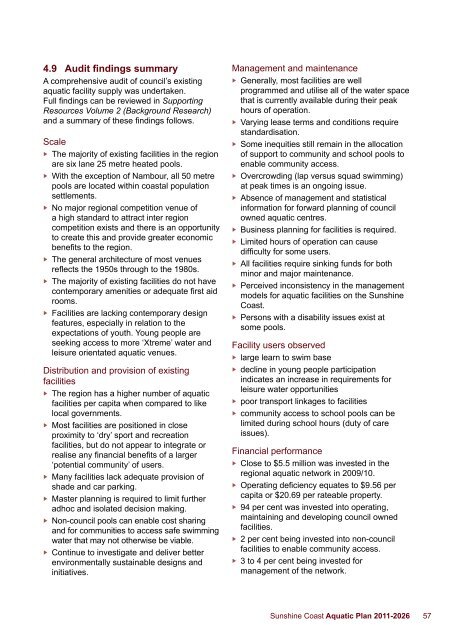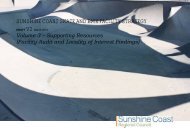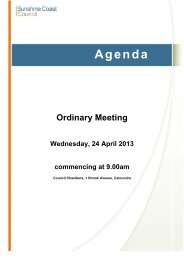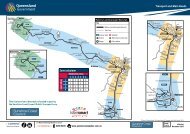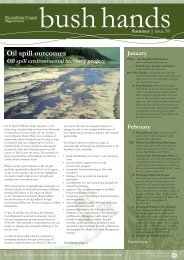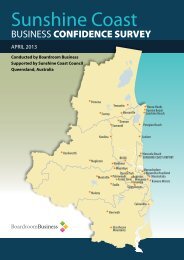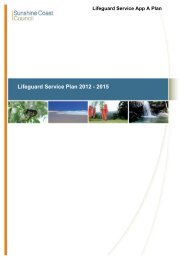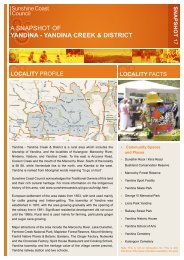Sunshine Coast Aquatic Plan 2011-2026 - Sunshine Coast Council
Sunshine Coast Aquatic Plan 2011-2026 - Sunshine Coast Council
Sunshine Coast Aquatic Plan 2011-2026 - Sunshine Coast Council
Create successful ePaper yourself
Turn your PDF publications into a flip-book with our unique Google optimized e-Paper software.
4.9 Audit findings summary<br />
A comprehensive audit of council’s existing<br />
aquatic facility supply was undertaken.<br />
Full findings can be reviewed in Supporting<br />
Resources Volume 2 (Background Research)<br />
and a summary of these findings follows.<br />
Scale<br />
►►<br />
►►<br />
►►<br />
►►<br />
►►<br />
►►<br />
The majority of existing facilities in the region<br />
are six lane 25 metre heated pools.<br />
With the exception of Nambour, all 50 metre<br />
pools are located within coastal population<br />
settlements.<br />
No major regional competition venue of<br />
a high standard to attract inter region<br />
competition exists and there is an opportunity<br />
to create this and provide greater economic<br />
benefits to the region.<br />
The general architecture of most venues<br />
reflects the 1950s through to the 1980s.<br />
The majority of existing facilities do not have<br />
contemporary amenities or adequate first aid<br />
rooms.<br />
Facilities are lacking contemporary design<br />
features, especially in relation to the<br />
expectations of youth. Young people are<br />
seeking access to more ‘Xtreme’ water and<br />
leisure orientated aquatic venues.<br />
Distribution and provision of existing<br />
facilities<br />
►►<br />
►►<br />
►►<br />
►►<br />
►►<br />
►►<br />
The region has a higher number of aquatic<br />
facilities per capita when compared to like<br />
local governments.<br />
Most facilities are positioned in close<br />
proximity to ‘dry’ sport and recreation<br />
facilities, but do not appear to integrate or<br />
realise any financial benefits of a larger<br />
‘potential community’ of users.<br />
Many facilities lack adequate provision of<br />
shade and car parking.<br />
Master planning is required to limit further<br />
adhoc and isolated decision making.<br />
Non-council pools can enable cost sharing<br />
and for communities to access safe swimming<br />
water that may not otherwise be viable.<br />
Continue to investigate and deliver better<br />
environmentally sustainable designs and<br />
initiatives.<br />
Management and maintenance<br />
►►<br />
►►<br />
►►<br />
►►<br />
►►<br />
►►<br />
►►<br />
►►<br />
►►<br />
►►<br />
Generally, most facilities are well<br />
programmed and utilise all of the water space<br />
that is currently available during their peak<br />
hours of operation.<br />
Varying lease terms and conditions require<br />
standardisation.<br />
Some inequities still remain in the allocation<br />
of support to community and school pools to<br />
enable community access.<br />
Overcrowding (lap versus squad swimming)<br />
at peak times is an ongoing issue.<br />
Absence of management and statistical<br />
information for forward planning of council<br />
owned aquatic centres.<br />
Business planning for facilities is required.<br />
Limited hours of operation can cause<br />
difficulty for some users.<br />
All facilities require sinking funds for both<br />
minor and major maintenance.<br />
Perceived inconsistency in the management<br />
models for aquatic facilities on the <strong>Sunshine</strong><br />
<strong>Coast</strong>.<br />
Persons with a disability issues exist at<br />
some pools.<br />
Facility users observed<br />
►►<br />
large learn to swim base<br />
►►<br />
►►<br />
►►<br />
decline in young people participation<br />
indicates an increase in requirements for<br />
leisure water opportunities<br />
poor transport linkages to facilities<br />
community access to school pools can be<br />
limited during school hours (duty of care<br />
issues).<br />
Financial performance<br />
►►<br />
►►<br />
►►<br />
►►<br />
►►<br />
Close to $5.5 million was invested in the<br />
regional aquatic network in 2009/10.<br />
Operating deficiency equates to $9.56 per<br />
capita or $20.69 per rateable property.<br />
94 per cent was invested into operating,<br />
maintaining and developing council owned<br />
facilities.<br />
2 per cent being invested into non-council<br />
facilities to enable community access.<br />
3 to 4 per cent being invested for<br />
management of the network.<br />
<strong>Sunshine</strong> <strong>Coast</strong> <strong>Aquatic</strong> <strong>Plan</strong> <strong>2011</strong>-<strong>2026</strong> 57


